Primary navigation
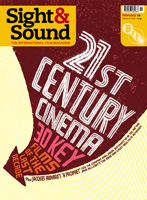
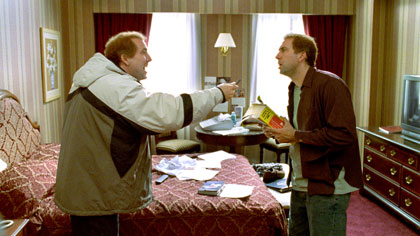
(Back to Nick James’ introduction to the films of the 2000s)
Spike Jonze, 2002
“Adaptation is something else. It is the revenge of the writer. For once this butt-of-all-jokes, the abused figure of the ‘creative team’, has somehow hijacked the production, locked the director and cast in his typewriter case and taken over the controls. The film’s writer, the real-life Charlie Kaufman, does this not just by putting his miserable alter ego at the centre of a story built around writer’s block, but by writing a film that is all about writing…
“Adaptation’s courage to insist on a different kind of subject matter – which, in turn, requires a different structure – is its triumph. As with Pulp Fiction (1994), one feels a door opening onto new possibilities for commercial film-making, a fractured, spontaneous, compulsive non-linearity, shaped not by the logic of ‘reality’ or the exigencies of narrative, but by the writer’s neurotic, obsessed mind, and able to go anywhere it wants, largely by renouncing fealty to the Hollywood ideals of tightness and clarity. Like Pulp Fiction, Adaptation holds its seemingly fragmentary structure together and turns it into a popularly accessibly form in part through the sheer delight of its freedom and invention, and in part because, despite appearances to the contrary, both films are so carefully organized that the audience never feel abandoned.” (Henry Bean, S&S March 2003)

Carlos Reygadas, 2005
“With his second feature, Carlos Reygadas confirms his status as the one-man third wave of Mexican cinema. Rejecting both the old style auteurism of Arturo Ripstein and the new, more audience-friendly manner of Alfonso Cuarón and Alejandro González Iñárritu, Reygadas ploughs a lonely and very distinctive furrow. Like the director’s previous film Japón, Battle in Heaven employs a very particular technique. Long takes and 360-degree pans are matched by idiosyncratic framing and sound design… The film is riddled with enigmas. While the synopsis reads like melodrama, the shooting and cutting style willfully sabotage narrative tension and dynamism.” (Paul Julian Smith, S&S November 2005)
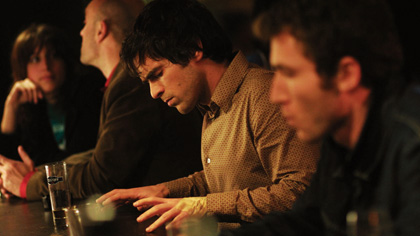
Jacques Audiard, 2005
“An updating, a rethinking and, in most ways, an improvement on Toback’s original Fingers. As in his previous movies, Audiard evidently doesn’t give a fig whether or not we like his protagonist. As played with icy dispassion by Romain Duris, Tom is, if anything, an even nastier piece of work than Keitel’s Jimmy. The latter’s victims do at least genuinely owe money (if only to his scuzzbag of a dad), while the wretches targeted by Tom and his associates just happen to be standing in the way of some corporate juggernaut. Strangely, this lack of conscience makes him more convincing in his other life as a once gifted piano prodigy. There’s a calm detachment, a not-quite-of-this-worldliness about even the most passionate and engaged of the great concert pianists (think Glenn Gould or Sviatoslav Richter)…” (Philip Kemp, S&S November 2005)
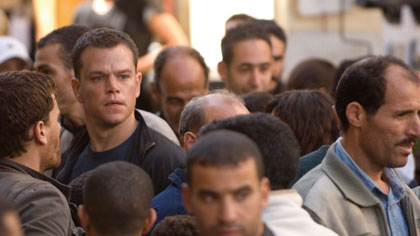
Paul Greengrass, 2007
“Once again, Greengrass’ marshalling of edgy handheld camerawork and whiplash editing is for more than show: it replicates the preternatural way that Bourne computes the world around him. And our experience is the same as those on his tail, just trying to keep up… The Waterloo station scene not only highlights the worrying ubiquity of CCTV in Britain, it suggests a scenario where the US would murder on British soil under the guise of national security. As with all good conspiracy thrillers, you would find no-one in an audience pausing to question this troubling notion.” (Demetrios Matheou, S&S October 2007)
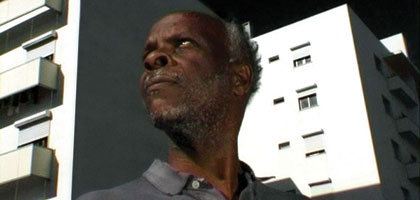
Pedro Costa, 2006
“The intransigently austere Colossal Youth is the kind of film that must usually look for its exposure in those areas beyond the remit of commercial distribution, where cinema meets moving-image gallery work. It is not a film you would expect to find in a premium slot in Cannes, but its inclusion in the festival’s 2006 competition was a welcome recognition of Portugal’s Pedro Costa as one of today’s most challenging and individual film-makers. [It] demands to be seen more than once: a first viewing just about lets you acclimatise to its mesmerically slow pacing, visual stillness and incantatory verbal rhythms…
“Costa’s engagement with Fontainhas’ former residents comes across as a profoundly democratic endeavour, one that does not mythologise its disadvantaged subjects but attempts, as it were, to ‘sing’ the collective memory of a defunct community. Formally hybrid, Colossal Youth has as much to do with still photography, and with non-narrative theatre, as with conventional ideas of cinema. No doubt the film will find only a very limited audience, yet it is surely destined to have a resounding influence on the future of European independent film-making. This is cinema povera of a kind that achieves a truly epic weight.” (Jonathan Romney, S&S June 2008)
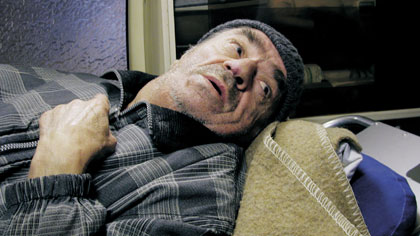
Cristi Puiu, 2005
“If [it sounds] like an extended episode of Casualty or ER (the last an acknowledged inspiration), The Death of Mr. Lazarescu also depicts as rich a human comedy, in the Balzacian sense, as anything in recent cinema. Puiu’s seemingly artless, documentary-style mise en scène, with the characters followed by a shoulder-mounted camera, conceals countless subtleties, foreshadowings and running themes… Puiu cites Eric Rohmer’s Moral Tales as his chief inspiration, but on this evidence an equally telling parallel would be Krzysztof Kieslowski’s Dekalog, though Puiu is more inclined towards self-conscious symbolism than the Pole. There are characters called Dante and Virgil and an unseen Dr Anghel, and the various hospital trips and their cyclical routines would match anyone’s idea of hell. And although the film’s title and mounting medical evidence suggests the opposite, Lazarescu’s own name hints that some kind of miraculous resurrection might be in prospect.” (Michael Brooke, S&S August 2006)

Jean-Luc Godard, 2001
“Memory, for Godard, has never been a straightforward given, complicated as it endlessly is by the questions of betrayal and representation. The former, all but omnipresent in his work from the American Patricia’s denunciation of Michel in Breathless, becomes inescapable in Éloge de l’amour through the revelation at the end from the historian (played by de Gaulle’s biographer Jean Lacouture) about the old couple’s past. The latter is most famously crystallised in Godard’s aphorism ‘It’s not a just image, it’s just an image’ – reprised in slightly altered form here – and is incessantly at work throughout Éloge de l’amour in the discussions around film-making and artistic production, as well as in the film’s visual texture. It is not only the industry, but also its audiences that have been in thrall to Hollywood. Godard’s practice, as the inclusion of Hollywood in the narrative of Éloge de l’amour indicates, is at once alternative and oppositional, knowing its enemy and working with playful intensity against it. If that makes the film difficult to watch, he might say, so much the better. Godard has been a foe of the uncomplicatedly consumable image right from the start.” (Keith Reader, November 2001)
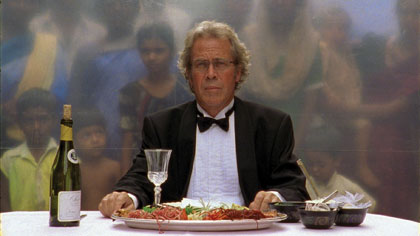
Jørgen Leth, Lars von Trier, 2003
“Von Trier has always been over-fond of bemoaning the pain of being impelled to make films: viewers have sometimes had better reason to bemoan the results. But he deserves great credit for his ongoing extracurricular efforts to provoke new debates about film form, in the course of which he is becoming – this he would hate to hear – a very endearing figure… [He] chides Leth for mounting a “highly affected distance” from what he films: he demands less art and more matter, certain that – even if the results are “banal”, even “crap” – the process, unstintingly yielded to, will be somehow therapeutic. But, whether or not Leth accepts von Trier’s premise, he is constitutionally incapable of obliging…” (Richard Kelly, S&S December 2003)
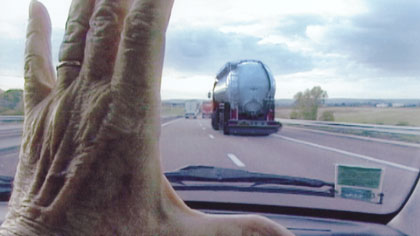
Agnès Varda, 2000
“Varda contrasts the backbreaking work of gleaners in the fields with the plight of the dispossessed, living in the margins in big cities today, foraging for food and scraps. 'What strikes me is that each person gleans on their own, whereas in paintings they were always in clusters, rarely alone,' she reflects, as she muses on such subjects as waste, thrift and social inequality. Varda also likens her own method to that of a gleaner: as an artist, she too is a gatherer, albeit of images, with her hyperrealistic lightweight digital camera. There is something comical about the director tramping through a field, filming potatoes in close-up. She turns up some heartrending stories about the dispossessed: for example, the former trucker who has been abandoned by his wife and family and now keeps himself alive by sifting through rubbish.” (Geoffrey Macnab, S&S December 2009)
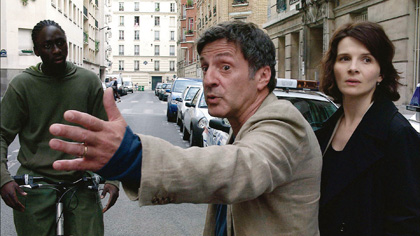
Michael Haneke, 2004
“Although presented as an ostensibly coherent psychological thriller, Hidden is really the latest of Haneke’s portraits of the bourgeois European family and its discontents… Hidden accuses the French intelligentsia – and, by extension, Western society – of a concerted denial of political and social reality… The film climaxes in an extraordinary act of blanking out the world: Georges retreats to his bedroom, draws the curtains and goes to bed. This action, the viewer can’t but notice, is similar to that of attending the cinema, and Haneke’s implied message is that we can use film either to deny reality or to face it head on…
“There is no conclusive literal explanation, nor should there be. Haneke, after all, has adapted Kafka for the screen; and, for all its concrete realism, Hidden, no less than The Castle (1997), demands to be viewed as parable – arguably, as Haneke’s most rigorous yet.” (Jonathan Romney, S&S February 2006)
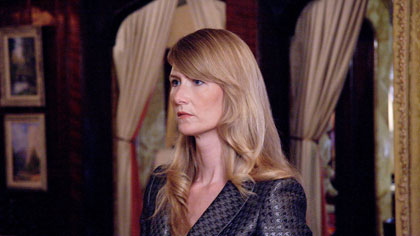
David Lynch, 2006
“Here is an undiluted, madcap splooge of purest grade-A cinema from our greatest and most uncompromising sui generiste, three aggressively nutsy hours long and so furiously self-involved, so hermetically sealed yet explosive and fascinating, so purely a movie and nothing else, that roping it into any category with other movies seems a dubious labour…
“Lynch has finally and irrevocably wagon-trained deep into farthest Lynchistan without a map, and we can’t expect to see him return to civilization any time soon. Trapped in its own bell jar, Inland Empire – taking its title from the Southern California region not because it’s set there, but simply because Lynch liked the name – summons the likes of Bergman’s Persona and Fellini’s Juliet of the Spirits in its allusive structure and suggestions of a fracturing female psyche, but only because the movie behaves like a narrative deprivation tank, forcing you to scrabble for corollaries. There are no visible marks of influence, homage or even traditional psychology. It’s one of the rare films that teaches you – obliquely – how to watch it… Endurance of [its] length is pivotal: the free-associative chaos becomes its own context, and as a viewer you’re living in a rule-free cinematic space, where film is merely another form of consciousness, not an alternate reality you can forget as you occupy it.” (Michael Atkinson, S&S April 2007)
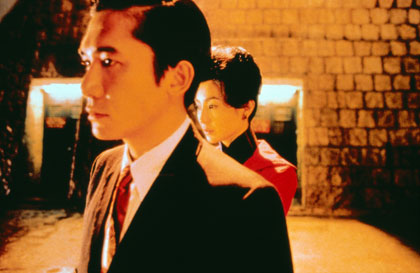
Wong Kar-Wai, 2000
“As always in Wong’s films, movement is eroticised. But here, there’s no rush, no dizzying climax to the movement. Instead, there is a more striking use of slow-motion images and of shots in which we see actors from behind as they move away from the camera’s eye. In one emblematic shot, the camera hovers behind Maggie Cheung as she climbs the stairs to her apartment, her swaying hips sheathed in one of her many flowered cheongsams, her rice bucket dangling from her hand. The shot is repeated at least three times, each repetition accompanied by the same slow dissonant mazurka on the soundtrack. The music, the slo-mo, and the incongruity of the elegant dress and the clumsy rice bucket make the moment seem like a dream…
“At the end of the film, the fragile hot-house world that nurtured the affair has disappeared, and we are returned to ourselves and the real world of crumbling empires with a newsreel clip of de Gaulle visiting Cambodia, and then with the visit to the ruins of Angkor Wat, which will outlive all – not only the story of Mr Chow and Mrs Chan’s love and loss but its memory as embodied in this exquisite, fragile film. In the Mood for Love ends with a title that speaks to its fetishistic quality: “The past is something he could see but not touch.” It’s not what’s present in the image that makes us desire to see this film again and again, but rather, the absence that haunts it.” (Amy Taubin, S&S November 2000)
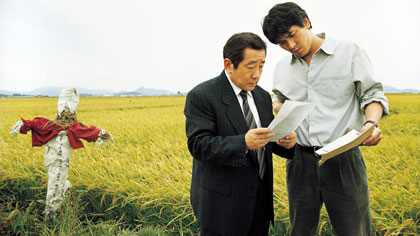
Bong Joon-ho, 2003
“Memories of Murder is based on a series of unsolved murders that took place between 1986-91 in provincial South Korea: ten women were raped and murdered but the killer was never brought to justice. Bong Joon-Ho’s remarkable film goes beyond telescoped details of the failed investigation to construct a desolate portrait of the rents in civil society. As two combative detectives – lazy local detective Park and his lean city rival Seo – clash, then gradually discard their contrasting professional principles, Bong tells a devastating story about the failures of both corruption and rigour and suggests a pessimism leeching through Korean society.” (David Jays, August 2004)
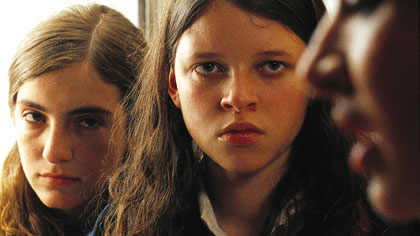
Lucrecia Martel, 2004
“A sultry ruck of girls aged 14 or 15 from the North Argentine town of La Ciénaga are discussing the nature of religious vocation. While they moodily angle their ripening features, all lips, hair and eyelashes caught in daylight from on high, they wonder what God has in store for them and speculate in whispers about the romantic activities of their teacher. In particular the camera lingers on the beestung face of actress María Alché, who plays Amalia, the holy girl of the film’s title. The way she looks at the time of shooting could not more perfectly represent a girl in the throes of puberty but with an imperfect understanding of the ways of the world. During the course of The Holy Girl the camera will dwell on her often, but with oddly angled close-ups of her earlobes, the top of her head or other fragmented intimacies. Such shots are the trademark of Argentinean director Lucrecia Martel, who has said her shooting style may derive from her own myopia – the world as seen by someone who wears strong prescription glasses. The Holy Girl is her second feature to grab the world'’s attention...” (Nick James, S&S February 2005)
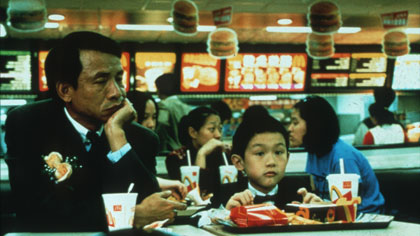
Edward Yang, 2000
“No narrative outline can hope to convey anything of the novelistic density of character and incident in Edward Yang’s wonderful film, or the richness. Across the relatively short time span of a few weeks – and a gone-in-a-flash running time of three hours – the film anthologises both the events which define a family (a birth, a marriage, a death) and the psychological stresses which people face at various ages (courtship rituals, mid-life crises, coping with the failures of relatives and friends, regretting lost opportunities). The Jian family at the centre of the film is absolutely typical of Taiwan’s middle class and its ups and downs are observed with a sociologist’s precision, but nothing here is alien to other countries, cultures or classes. This is view of contemporary urban life as plausible and comprehensive as any cinema has to offer, its elements of soap opera and melodrama integrated as skillfully as its sense of the interconnectedness of things.” (Tony Rayns, S&S April 2001)
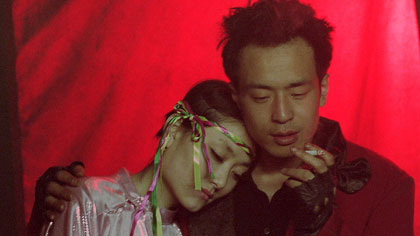
Jia Zhangke, 2000
“Platform employs the microcosm of an itinerant theatre troupe to chart the massive upheavals in Chinese society during the 1980s. As economic liberalism takes hold, the commune gradually splinters – ground down by unseen external forces beyond its control. The director mimics these transformations through slow, painful adjustments in his style. When the characters are still in their Maoist phase, the twinning of a static camera with extreme long shots underwrites a hidebound, insular republic which effectively reduces its citizens to anonymous specks. Once the free market kicks in, however, a few discreet pans and medium shots are grudgingly conceded – all but wrestled from the mise en scène by the strength of the newly unleashed desires. Platform describes the death throes of the old collectivized world and the birth spasms of the private self. Yet Jia the sober determinist scarcely views the change as a deliverance – more like the inexorable operation of the material base upon the cultural superstructure.” (Peter Matthews, S&S July 2003)
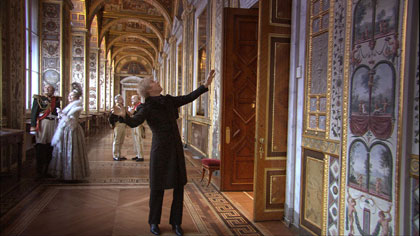
Aleksandr Sokurov, 2002
“If history and culture are flux and irresolution, then perhaps we can best address them through a journey which alternates fluid motion with moments of stasis and periods of dizzying convulsion. Watching the film you do sometimes, in its periods of calm, forget that there has not been a single cut – only to be rocked into elated admiration when the camera jerks you away into another headlong pursuit.
“The sheer, brazen ambition of the project is never so apparent as in the film’s stunning final sequences. Characters glimpsed at the start come back for a grand ball, given in 1913 on the eve of World War. The orchestra plays. The dancers, Custine among them, perform a precisely drilled mazurka. The older characters stand watching the spectacle, purring approval. And the camera roves and darts among them, both recording and sharing their élan. When the dance is over, the dancers express their delight in the orchestra’s performance, but also in their own contribution, through prolonged applause. The sense of exuberance, of human harmony, of cultural achievement, is electrifying. But there is also a powerful sense of ending. In another bravura sequence, the guests leave, down the building’s grand double staircase, and the camera performs a swift backward tracking shot out into the cold night. Custine is lost in the throng and the narrator describes his sense of melancholy. The Hermitage is an ark, Russia is an ark, human history is an ark. In the film’s dying words, ‘And we must drift forever, and we must live forever.’” (Julian Graffy, S&S April 2003)
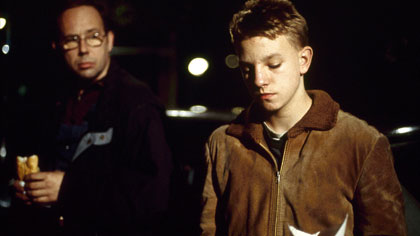
Jean-Pierre & Luc Dardenne, 2002
“Cinematically speaking, Luc and Jean-Pierre Dardenne are a modern-day miracle. They make detailed, tangible accounts of workaday life, their milieu an unlovely post-industrial Belgium; and yet these films are hinged on the gravest moral questions, their dramatic temper worthy of Sophocles or Dostoevsky. La Promesse and Rosetta were studies in conscience and betrayal; The Son weighs the balance of revenge and forgiveness.” (Richard Kelly, S&S March 2003)
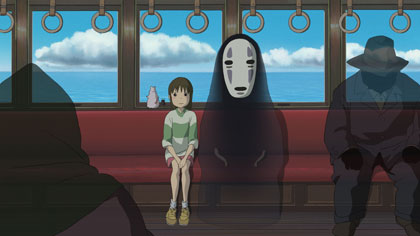
Miyazaki Hayao, 2001
“Spirited Away, a Japanese animated fantasy about a little girl’s adventures in a realm of gods and monsters, invites comparisons to the Alice books, The Wizard of Oz and even Harry Potter. First and foremost, though, this remarkable film is embedded in the personal universe of its auteur-director Hayao Miyazaki, whose standing in Japan is comparable to Steven Spielberg’s or, indeed, J.K. Rowling’s in the west… It’s deeply recursive, uniting themes and images from across the director’s past work. To take the most obvious example, the soot-sprites that toil in the boiler room of the spider-man Kamaji here appear in a different role in Miyazaki’s My Neighbour Totoro (1988), while many other elements form part of what might be called Miyazaki-land: his fascination with flight, ecology, elaborate buildings, strong girls, weary gods, overbuilt machinery, empowering labour, even the pigs heroine Chihiro’s gluttonous parents turn into.” (Andrew Osmond, S&S September 2003)
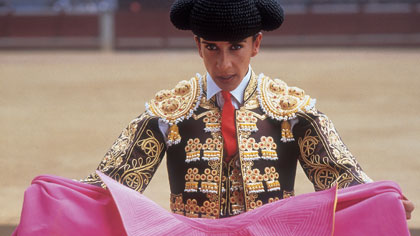
Pedro Almodóvar, 2002
“For those, like myself, who though Live Flesh was great and All About My Mother perfection, it is hard to articulate how Talk to Her can be better – and yet it is. It’s not just that it’s beautiful to look at or that it contains so many moments nonpareil (a superb Geraldine Chaplin, the voice of Caetano Veloso at its most angelic). It’s that Almodóvar seems to be able to marshal an unlimited range of film-making ingredients and extract from them every measure of their worth. Somehow he can take morally and emotionally difficult subject matter and make something familiar and new: a supremely complex story, simply told, which conveys a range of feeling at once precise and endlessly evocative.” (José Arroyo, S&S September 2002)
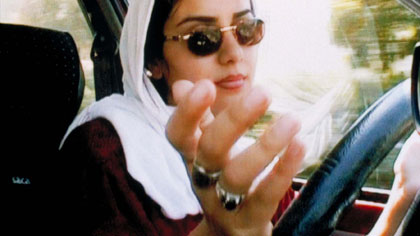
Abbas Kiarostami, 2002
“Given what may appear to be a randomly structured narrative and the absolute plausibility of everything we see and hear, it would be easy to assume that 10 is a fly-on-the-windscreen documentary. But Kiarostami is a director who repeatedly returns to that treacherous but very fertile no-man’s land between fiction and non-fiction, and 10 is merely the latest and arguably most sophisticated in [his] series of forays into phenomenological and narrative ambiguity… But one can’t help feeling there are other things going on in 10, specifically linked to Kiarostami’s conversion to the digital camera. The ‘realism’ on view here is unimaginable without the new technology: before digital any camera would have been too obtrusive, distracting the actors and making them self-conscious. Kiarostami has spoken of his desire to make direction itself disappear… 10 has everything to do with using cinema as a tool for the cool, sympathetic contemplation – and celebration – of the uncertainties of everyday life. It may just be that Kiarostami’s quiet minimalism, more than anything else now on our screens, points to the most richly rewarding route cinema might take on its journey into the future.” (Geoff Andrew, S&S October 2002)

Paul Thomas Anderson, 2007
“Anderson may be setting up fundamentalist religion and rapacious big business as deadweights around America’s neck – or even as the twin causes of the country’s current predicament – but he presents them as rivals rather than in cahoots. In any case, with a film so firmly based on the shoulders of one maniacal character, such wider considerations seem secondary… It is one of the features of There Will Be Blood that while it evokes the great outdoors in scale, its themes remain internal. Right from its opening shot of three barren hills (where the silver mine lurks), it drinks in the landscape and air with all the enthusiasm of Heaven’s Gate-era Michael Cimino without ever letting the picturesque dominate its characters. Carved with stark simplicity, it nevertheless delivers a thoroughly imagined and complex world of social, moral, political and religious forces.” (Nick James, S&S February 2008)
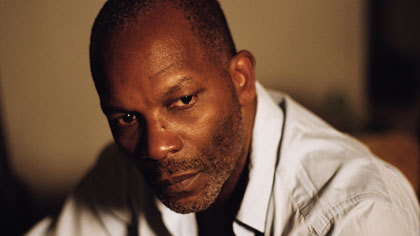
Claire Denis, 2008
“35 Shots of Rum sees Denis turn her inimitable gaze towards the filial bond. Inspired both by Ozu’s Late Spring and Hou Hsiao-hsien’s homage to it, Café Lumière, as well as by the director’s observations of her own mother and grandfather, the film has at its softly palpitating heart the relationship between widower Lionel (Alex Descas) and his college-age daughter Josephine (film-maker Mati Diop, niece of Senegalese director Djibril Diop Mambéty).
“Much has been made of Denis’ pitch-perfect portraits of desire… Critics have been slower to recognise Denis as the great chronicler of jealousy – strange when one thinks how its throbbing undertow runs beneath so many of her films. As the director has repeated in interviews, for her, “desire is violence”. Here, every moment of longing that makes our stomachs flip, every electric touch that sends a crackle through our skin, is overwritten with the awareness of watching eyes, of a bond being broken for each new one that is forged. The pale, gleaming skin of Jo’s bare shoulders, lovingly caressed by Lionel as they dance, becomes a landscape to be fought for as Noe’s hand glides over it. And yet while the spectre of violence, or at least of careless brutality, hovers around the edges of [the film], there it remains.… 35 Shots of Rum finally resolves as a profoundly warm, tender and surprisingly optimistic work.” (Catherine Wheatley, S&S August 2009)

Kevin Macdonald, 2003
“A vivid… highly focused, clutter-free experience, mixing recently shot to-camera interviews with dramatic reconstructions. The form is familiar from TV reality series such as the BBC’s 999, but MacDonald raises it to unprecedented levels of cinematic spectacle, suspense and apparent authenticity… [His] focus on recreating events as authentically as possible pays dividends… MacDonald wants to make us feel as much of [mountaineer Joe] Simpson’s pain and dread on the way to his extraordinary reprieve as the tools of narrative cinema allow. His shooting of the key sequence inside a real crevasse adds its own claustrophobia to Simpson’s voiceover description, reminiscent of the Poe of The Pit and the Pendulum: “Crevasses have a dread feel, not a place for the living… I hung on the rope and waited to die.” (Richard Falcon, S&S January 2004)
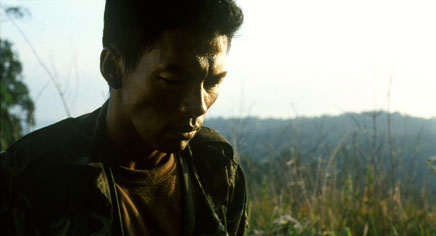
Apichatpong Weerasethakul, 2004
“The gay love-story which is the kernel of the first section asks for no special treatment… But it is Weerasethakul’s intention to go directly and strongly to the world of Joseph Beuys and William Blake, and by the time we get to the second section he is determined to evoke a place that is defiantly other-worldly. The darkness of this jungle is infinite, and Weerasethakul is careful to leave it dark… Weerasethakul’s passion for the forest floor is also considerable: few have ever attended to its structure in such detail, with its paw-prints, twigs, dead leaves, snail shells, fly-blown turds, leeches and most of all mud. It is only by smearing himself with mud, like Arnie in Predator, that the soldier stands any chance of outwitting his tiger-spirit nemesis…
“This is a work of outstanding originality and power that comes nearer to the condition of the quest and the dream-state than any film in recent years. It requires a relaxed and open mind to watch it, be consumed by it, and enjoy its great and fearful symmetry.” (Roger Clarke, S&S March 2005)
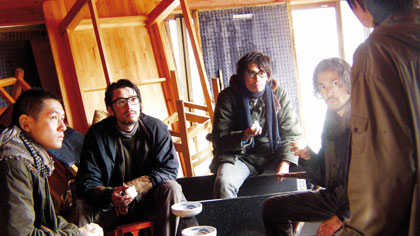
Wakamatsu Koji, 2008
“[Wakamatsu] vindicates his entire career with United Red Army, a 190-minute docu-drama that traces the history of the terrorist left in Japan from its origins in 1960 (the violent protests against the renewal of the US-Japan Security Pace) to its end in 1972/3 with the police siege of the last hold-outs in a mountain lodge and the suicide in prison of the leader/ideologue Mori Tsuneo. Thanks to scarily convincing performances and a Peter Watkins-like objectivity in the telling, this gets as close as anyone will ever need to understanding how extremist groups function and why they end up imploding. Wakamatsu knew, liked and worked with some members of the group in the 1960s; he tells their story partly to write a history that’s already almost forgotten but mainly to inform present-day drones that kids not so long ago lived and died for their beliefs.” (Tony Rayns, S&S April 2008)
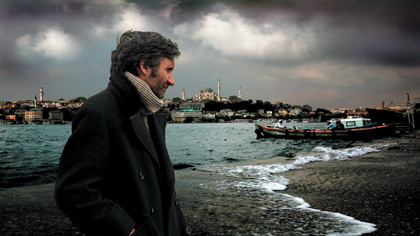
Nuri Bilge Ceylan, 2003
“Little is said throughout: Uzak is a film of missed encounters and failed communications… In its taciturn, appropriately distant fashion, [it] strikes you very much as a personal contemplation, even if you don’t know how much of it reflects the director himself, who has said the film is an accurate depiction of his lifestyle in the years before his first marriage and after his divorce… Ceylan’s three features convey an impressive clarity of vision. The path from Kasaba to Uzak reveals a film-maker whose register is subtly expanding, with a melancholic moral perspective, a sharp, understated wit and a keen eye for the revealing, ostensibly empty moments of everyday living. In Uzak Ceylan emerges as an ambitious geographer of city life, exploring the spaces that irrevocably separate people, both in the street and indoors.” (Jonathan Romney, S&S June 2004)
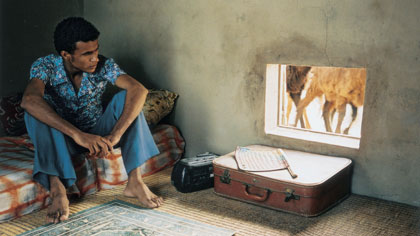
Abderrahmane Sissako, 2002
“Sissako’s latest feature is less a story than a state of mind. In this little settlement on the far-western edge of Africa, precariously perched between two shifting, shape-changing elements (sea and sand), everyone is poised in a state of transience. There’s a feeling of people tentatively reaching out, trying to make connections that may at any moment be severed. Abdallah, the nominal hero, is only the most extreme case, isolated by his linguistic handicap…” (Philip Kemp, S&S November 2003)

Béla Tarr, Agnes Hranitzky, 2000
“[Tarr] represents a hardline belief in a cinema of patience and severity, of tableaux and long takes, in some ways echoing that of his countryman Miklós Jancsó… As a metaphysical horror story, Werckmeister Harmonies deserves to be Tarr’s breakthrough with a cult audience, especially since its atmosphere bears comparison with early David Lynch. The hermetic world Tarr creates is ineffably mysterious, yet the film’s representation is rooted in a scrupulously mundane naturalism… The enigmatic harmonic preoccupations alluded to in the title suggest that this film – rich in movement, low on dialogue – aspires, as the old phrase has it, to the condition of music. But Tarr’s true achievement is to attain the condition of silence, and of bottomless, awesomely inscrutable nightmare.” (Jonathan Romney, S&S April 2003)
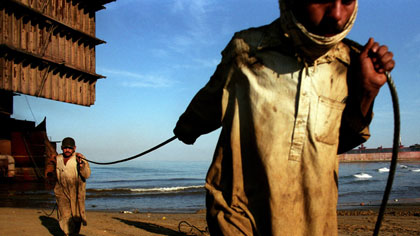
Michael Glawogger, 2005
Festooned with awards (including the Grierson documentary prize at the 2005 London Film Festival) but crazily never distributed in the UK, Glawogger’s epic portrait of the back side of globalisation might be the finest of a rich crop of globe-trotting documentaries to emerge from Austrian film-makers during the 2000s. Shot in rich 35mm long shots further amplified by a John Zorn score, it monumentalises the unsung labours of manual workers in five corners of the world – freelance Ukrainian coal-mining desperadoes, volcano-braving Javanese sulfur-haulers, Bruegelesque open-market butchers in Port Harcourt, Nigeria, lonely male Pashtun shipbreakers on the Arabian coast, and insecure steelworkers in rapidly modernising Anshan, China. A coda sees German children playing on the repurposed remains of the great 20th-century Duisburg-Meiderich smelting works, begging the question – is the film charting the 21st-century death of heavy labour, or merely its recession from our view? (Nick Bradshaw, 2010)
See Nick James’ introduction to the films of the 2000s
The Sight & Sound Top Ten Poll of the best films of all time